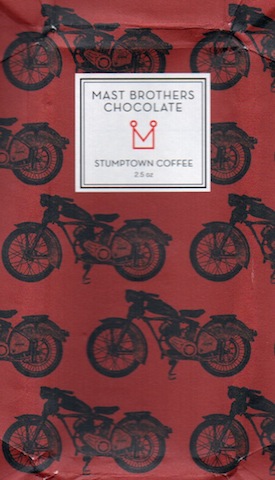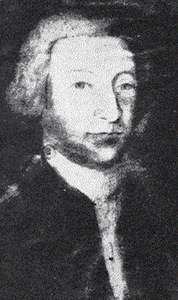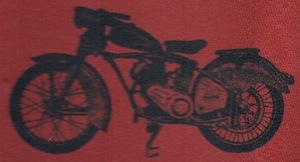
Impact
Lost among the buzz-bomb that has become the Mast Bros -- those media-darlings of the new era choc with roots planted among Brooklyn USA's über-hipster scene who, some report, look like a pair of brothers that should be elsewhere, like driving a horse 'n buggy thru Amish country around Lancaster, PA -- is that they operate in a 'hood populated by Hasidim.
On any given night, the Hasid are out & about, easy to spot with the curlicue sidelocks (called payot) under a black fedora or the fur-trimmed shtreimel hat, dressed in black frock coats often of splendid silk thread.
Some, seemingly, just walking around in clusters, even at 4AM. Others in couples, the women equally dark robed. If looks alone can kill then these guys are all morningwood stiffs because most of their ladies are drop-dead gorgeous. Seriously, it's uncanny. By God, how does that happen?
Such beautiful digressions but returning on point... Jews & chocolate go way back. Though not quite at the heart of chocolate history, they provide important footnotes to it.
When even conversos (Jewish converts to Christianity) were expelled from Spain during the Inquisition, a few beat it out of town by hopping on Columbus' boat to the New World (Maestre Bernal, Alphonso de La Calle, Roderigo Sanchez de Segovia, Luis de Torres, & Roderigo de Triana). Prior to sailing, Columbus consulted with Abraham Zacuto who developed a new type of astrolabe for determining latitude at sea & helped plot the route. A Judaic scholar, Zacuto no doubt encouraged the navigator that the Earth, rather than flat, is made as a ball, according to the Talmud. Of course both men in a sense were wrong too... Columbus never made it to his preferred destination -- India -- because America sat in the way.
The crew on Columbus' 4th voyage in 1502 were the first known Europeans to ever encounter cacáo.
More Jews escaped the Iberian Peninsula overland & sea by heading north across the French border to Bayonne. There they formed guilds, including some of the earliest chocolate-makers in that country. Folklore even has it that Jews introduced chocolate into France, a tale repeated by modern-day tourist offices & museums in the area (though no documents for substantiating it exist). This narrative may serve to play up the primacy of Bayonne chocolate vis-a-vis Parisian chocolatiers (such as La Maison du Chocolat, Jacques Genin, Patrick Roger, Michel Chaudun, et. al.) & more significantly the great Rhone Valley barsmiths (Bonnat, Pralus, & Morin). It also would establish Bayonne closer -- both culturally as well as geographically -- to the original entry point of cacáo into Europe (which was Spain), if not the very source (the Americas), bestowing upon it an edge of greater authenticity. Then again, the Jewish tale of Bayonne might simply atone for the Dreyfus Affair & Vichy France that continues to guilt the national psyche.
Later & elsewhere, Jews on the Chocolate Trail , which is the title of a forthcoming book by Rabbi Debbie Prinz, would include Benjamin Andreade de Acosta. He was deported from Portuguese Brazil in 1660 for being, well, Jewish; but not before leaving with some cacáo seeds which he transplanted to the French-controlled island of Martinique in the Caribbean of an Amazonian varietal known as ‘Martinique Creole’. Soon thereafter Martinique was the prime supplier of cocoa beans to chocolate makers back home in France.
Martinique also turned into a hub or distribution center of sorts for cacáo throughout the Caribbean & Central America. Until the late 20th century, Basil Bartley writes that the only significant addition to Central American cacáo since Columbus was the introduction of an Amazonian genotype, probably the same as the Martinique ‘Creole’.
Bartley's hypothesis remains conjectural & awaits further DNA analysis. If he's correct, Martinique ‘Creole’ found its way to the mainland, first as a strain named ‘Matina’ in present-day Costa Rica, then rechristened ‘Ceylon’ upon reaching Mexico. Whatever its label & provenance, it appears all over the continent today… the entire length from Panama northwards.
 Then there was Aaron Duarte Lopez whose Judaism compelled him to emigrate to America, arriving in Newport, RI during the autumn of 1752. Lopez is extolled as the 1st Jew to be naturalized in Colonial New England though that distinction probably belongs to his brother, Moses. Whatever the case, he ranked among the most important & wealthiest merchants on the eastern seaboard, earning him the moniker "The Merchant Prince". Aaron owned 30+ ships -- roughly a quarter of the entire Newport fleet -- trading between North America, Europe & the Caribbean, part of a diverse & expanding business portfolio that saw him forge an alliance with 8 other merchants to fix the distribution & price of sperm whale oil used for candles (the light bulbs of their day). Also among the cargo: slaves & cocoa, the latter of which he was a major importer as well as producer for chocolate.
Then there was Aaron Duarte Lopez whose Judaism compelled him to emigrate to America, arriving in Newport, RI during the autumn of 1752. Lopez is extolled as the 1st Jew to be naturalized in Colonial New England though that distinction probably belongs to his brother, Moses. Whatever the case, he ranked among the most important & wealthiest merchants on the eastern seaboard, earning him the moniker "The Merchant Prince". Aaron owned 30+ ships -- roughly a quarter of the entire Newport fleet -- trading between North America, Europe & the Caribbean, part of a diverse & expanding business portfolio that saw him forge an alliance with 8 other merchants to fix the distribution & price of sperm whale oil used for candles (the light bulbs of their day). Also among the cargo: slaves & cocoa, the latter of which he was a major importer as well as producer for chocolate.
Jacob Marcus writes in The Colonial American Jew that "in Newport relatively large quantities of chocolate were prepared for Lopez by Negroes whose Jewish masters may have taught them the art".
Lopez bet on the winning side in the American War of Independence against the British, helping the Yankee cause, but lost his fortune in the process. The rebellion brought food shortages, particularly acute for kosher Jews. Right in the teeth of the conflict in 1779 he wrote that they're "forced to subsist on chocolate & coffee."
S'pose worse diets can be imagined.
This then The Aaron Lopez Bar in homage to Jews & Chocolate. The kind for survival rations, with plenty of methyxanthine cousins (caffeine + theobromine) to go a long way on. And, if starved enough, perhaps even thrive on... like the hungry yelpers queuing up inside the Mast Bros Brooklyn outlet.
On any given night, the Hasid are out & about, easy to spot with the curlicue sidelocks (called payot) under a black fedora or the fur-trimmed shtreimel hat, dressed in black frock coats often of splendid silk thread.
Some, seemingly, just walking around in clusters, even at 4AM. Others in couples, the women equally dark robed. If looks alone can kill then these guys are all morningwood stiffs because most of their ladies are drop-dead gorgeous. Seriously, it's uncanny. By God, how does that happen?
Such beautiful digressions but returning on point... Jews & chocolate go way back. Though not quite at the heart of chocolate history, they provide important footnotes to it.
When even conversos (Jewish converts to Christianity) were expelled from Spain during the Inquisition, a few beat it out of town by hopping on Columbus' boat to the New World (Maestre Bernal, Alphonso de La Calle, Roderigo Sanchez de Segovia, Luis de Torres, & Roderigo de Triana). Prior to sailing, Columbus consulted with Abraham Zacuto who developed a new type of astrolabe for determining latitude at sea & helped plot the route. A Judaic scholar, Zacuto no doubt encouraged the navigator that the Earth, rather than flat, is made as a ball, according to the Talmud. Of course both men in a sense were wrong too... Columbus never made it to his preferred destination -- India -- because America sat in the way.
The crew on Columbus' 4th voyage in 1502 were the first known Europeans to ever encounter cacáo.
More Jews escaped the Iberian Peninsula overland & sea by heading north across the French border to Bayonne. There they formed guilds, including some of the earliest chocolate-makers in that country. Folklore even has it that Jews introduced chocolate into France, a tale repeated by modern-day tourist offices & museums in the area (though no documents for substantiating it exist). This narrative may serve to play up the primacy of Bayonne chocolate vis-a-vis Parisian chocolatiers (such as La Maison du Chocolat, Jacques Genin, Patrick Roger, Michel Chaudun, et. al.) & more significantly the great Rhone Valley barsmiths (Bonnat, Pralus, & Morin). It also would establish Bayonne closer -- both culturally as well as geographically -- to the original entry point of cacáo into Europe (which was Spain), if not the very source (the Americas), bestowing upon it an edge of greater authenticity. Then again, the Jewish tale of Bayonne might simply atone for the Dreyfus Affair & Vichy France that continues to guilt the national psyche.
Later & elsewhere, Jews on the Chocolate Trail , which is the title of a forthcoming book by Rabbi Debbie Prinz, would include Benjamin Andreade de Acosta. He was deported from Portuguese Brazil in 1660 for being, well, Jewish; but not before leaving with some cacáo seeds which he transplanted to the French-controlled island of Martinique in the Caribbean of an Amazonian varietal known as ‘Martinique Creole’. Soon thereafter Martinique was the prime supplier of cocoa beans to chocolate makers back home in France.
Martinique also turned into a hub or distribution center of sorts for cacáo throughout the Caribbean & Central America. Until the late 20th century, Basil Bartley writes that the only significant addition to Central American cacáo since Columbus was the introduction of an Amazonian genotype, probably the same as the Martinique ‘Creole’.
Bartley's hypothesis remains conjectural & awaits further DNA analysis. If he's correct, Martinique ‘Creole’ found its way to the mainland, first as a strain named ‘Matina’ in present-day Costa Rica, then rechristened ‘Ceylon’ upon reaching Mexico. Whatever its label & provenance, it appears all over the continent today… the entire length from Panama northwards.
 Then there was Aaron Duarte Lopez whose Judaism compelled him to emigrate to America, arriving in Newport, RI during the autumn of 1752. Lopez is extolled as the 1st Jew to be naturalized in Colonial New England though that distinction probably belongs to his brother, Moses. Whatever the case, he ranked among the most important & wealthiest merchants on the eastern seaboard, earning him the moniker "The Merchant Prince". Aaron owned 30+ ships -- roughly a quarter of the entire Newport fleet -- trading between North America, Europe & the Caribbean, part of a diverse & expanding business portfolio that saw him forge an alliance with 8 other merchants to fix the distribution & price of sperm whale oil used for candles (the light bulbs of their day). Also among the cargo: slaves & cocoa, the latter of which he was a major importer as well as producer for chocolate.
Then there was Aaron Duarte Lopez whose Judaism compelled him to emigrate to America, arriving in Newport, RI during the autumn of 1752. Lopez is extolled as the 1st Jew to be naturalized in Colonial New England though that distinction probably belongs to his brother, Moses. Whatever the case, he ranked among the most important & wealthiest merchants on the eastern seaboard, earning him the moniker "The Merchant Prince". Aaron owned 30+ ships -- roughly a quarter of the entire Newport fleet -- trading between North America, Europe & the Caribbean, part of a diverse & expanding business portfolio that saw him forge an alliance with 8 other merchants to fix the distribution & price of sperm whale oil used for candles (the light bulbs of their day). Also among the cargo: slaves & cocoa, the latter of which he was a major importer as well as producer for chocolate.Jacob Marcus writes in The Colonial American Jew that "in Newport relatively large quantities of chocolate were prepared for Lopez by Negroes whose Jewish masters may have taught them the art".
Lopez bet on the winning side in the American War of Independence against the British, helping the Yankee cause, but lost his fortune in the process. The rebellion brought food shortages, particularly acute for kosher Jews. Right in the teeth of the conflict in 1779 he wrote that they're "forced to subsist on chocolate & coffee."
S'pose worse diets can be imagined.
This then The Aaron Lopez Bar in homage to Jews & Chocolate. The kind for survival rations, with plenty of methyxanthine cousins (caffeine + theobromine) to go a long way on. And, if starved enough, perhaps even thrive on... like the hungry yelpers queuing up inside the Mast Bros Brooklyn outlet.
Appearance 3 / 5
| Color: | a kind of oriole (burnt-apricot brown) |
| Surface: | some shreds peeling off the main tread; + minor potholes |
| Temper: | ruffian & a little bald in areas |
| Snap: | no kick-starter at all... needs a running jump; crumble cake on the edge wall |
Aroma 6.8 / 10
 Bros are nothing if not retro-cool & this fits the motorcycle image on the wrapper... of a primitive frame to recall Jawa bikes from Poland (a stomping ground of the Hasidim back in Europe), certainly nowhere near the iconic Triumph Thunderbird that Brando rode in The Wild One, but leaking oil all the same (as Triumphs engines were prone) & so stuck on the pavement with cardboard beneath the tires (serious storage situation) leaking both black crude (coffee) + a lighter grade (cocoa butter) -> those characteristic Madagascar volatiles (the base cocoa for this bar) expressed as acetic acid / vinegar for some flea-bait which the back exhaust gasses out as beautiful citrus blossoms in an engineering marvel
Bros are nothing if not retro-cool & this fits the motorcycle image on the wrapper... of a primitive frame to recall Jawa bikes from Poland (a stomping ground of the Hasidim back in Europe), certainly nowhere near the iconic Triumph Thunderbird that Brando rode in The Wild One, but leaking oil all the same (as Triumphs engines were prone) & so stuck on the pavement with cardboard beneath the tires (serious storage situation) leaking both black crude (coffee) + a lighter grade (cocoa butter) -> those characteristic Madagascar volatiles (the base cocoa for this bar) expressed as acetic acid / vinegar for some flea-bait which the back exhaust gasses out as beautiful citrus blossoms in an engineering marvel
Mouthfeel 7.6 / 15
| Texture: | poor Textural integrity; grain |
| Melt: | quick dissolve / disintegration to a nicely fat / voluminous round-up |
Flavor 30.1 / 50
that color-coordinated wrapper extends to a full sensory synesthesia... the black reps coffee, the red Madagascar (both for its nickname as the 'Red Island' & its oft-red berry-laden fruits inhering within its cacáo): instant sour-coffee (tastes better than it sounds) as the cocoa-acids & the coffee-tannins battle to a near wash out (call it "stump juice") -> thick hazel-peanut butter paste at the base (sounds much better than it tastes... horrendous), the offshoot to the cardboard in the the Aroma -> ammonia (what the liner notes refer to as 'tobacco'?)... spared only by round-fat at the back -> saves the best for last: a full throttle coffee spit
Quality 11.4 / 20
A Redux Review of sorts on Mast's 72% Dark+Coffee from the 2010 Vintage.
If that's a tornado of a chocolate bar-cum-coffee cup, this then the MC Hasidim (for a Hasid' on a motorcycle). Superfast dissolve on the melt, despite the updated version here hewing 2% more cacáo.
Nonetheless, virtually no chocolate flavor whatsoever. Just a cold mess... coffee welded to the Mast's rank Madagascar chocolate in a fun clash / spectacular crash... ultimately incongruous, incompatible & inevitably doomed.
Haphazard construction / technique add to the woes. The Bros calling it a day & sleeping on it while interns try their hand at making student mistakes.
Taken together with their recent San Martin release, meticulous obsession to craft apparently failed to make the move to the label's upgraded digs. With the Bros' expanding ops to include a tasting room & "corporate" offices so to speak, plus the ancillary logistics to growing a business, who can be bothered with such details?
Rabid fan girlz 'n boyz will still feel stroked rather than stumped however. That is, punk'd by some Brooklyn funk.
Sing it.
INGREDIENTS: cocoa, sugar
Reviewed June 7, 2012
If that's a tornado of a chocolate bar-cum-coffee cup, this then the MC Hasidim (for a Hasid' on a motorcycle). Superfast dissolve on the melt, despite the updated version here hewing 2% more cacáo.
Nonetheless, virtually no chocolate flavor whatsoever. Just a cold mess... coffee welded to the Mast's rank Madagascar chocolate in a fun clash / spectacular crash... ultimately incongruous, incompatible & inevitably doomed.
Haphazard construction / technique add to the woes. The Bros calling it a day & sleeping on it while interns try their hand at making student mistakes.
Taken together with their recent San Martin release, meticulous obsession to craft apparently failed to make the move to the label's upgraded digs. With the Bros' expanding ops to include a tasting room & "corporate" offices so to speak, plus the ancillary logistics to growing a business, who can be bothered with such details?
Rabid fan girlz 'n boyz will still feel stroked rather than stumped however. That is, punk'd by some Brooklyn funk.
Sing it.
INGREDIENTS: cocoa, sugar
Reviewed June 7, 2012




